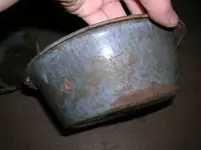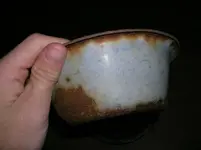Monty, I hate to disagree with someone I consider extremely knowledgeable, but I'm afraid you're wrong on this one. Porcelain is a highly prized item used for decorative items and expensive china, whereas graniteware is ironware coated with an enamel substance.
"gran?ite?ware
Pronunciation: (gran'it-w?r"), [key] ?n.
1. a kind of ironware with a gray, stonelike enamel.
2. pottery with a speckled appearance like that of granite.
3. a semivitreous white pottery somewhat harder than earthenware"
"porcelain [Ital. porcellana], white, hard, permanent, nonporous pottery having translucence which is resonant when struck. Porcelain was first made by the Chinese to withstand the great heat generated in certain parts of their kilns. The two natural substances used were kaolin, also known as china clay, a white clay free of impurities that melts only at very high temperature, and a feldspar mineral called petuntse that forms a glassy cement, binding the vessel permanently. Although proto-porcelain wares exist dating from the Shang, by the Eastern Han high firing glazed ceramic wares had developed into porcelain, and porcelain manufactured during the T'ang period (618?906) was exported to the Islamic world where it was highly prized. .. In Europe porcelain was first commercially produced (1710) in Meissen, Germany. Most of the European porcelain is soft paste (made from clay and an artificial compound such as ground glass) and is not as strong as the Chinese hard-paste porcelain. Important European centers for porcelain are Bow, Chelsea, Worcester, Staffordshire, Vienna, Meissen, S?vres, Limoges, and Rouen."
Maybe the plant your father worked for did produce porcelain, but if he brought home pots of metal covered in a porcelain-like substance (enamel, much weaker and more porous than porcelain), it was probably graniteware, if not enamelware.
In a way it's like comparing glass to plexiglass. Same use, different recipes.

Noodle








 :P So which one is it. i think its graniteware cause that sounds more farmiliar
:P So which one is it. i think its graniteware cause that sounds more farmiliar 
 Do a "graniteware" search on ebay to see some, or any google search for "graniteware." You'll see all sizes, shapes and colors, including some that looks like Jake's. Also referred to as enamelware.
Do a "graniteware" search on ebay to see some, or any google search for "graniteware." You'll see all sizes, shapes and colors, including some that looks like Jake's. Also referred to as enamelware. ?
? 
